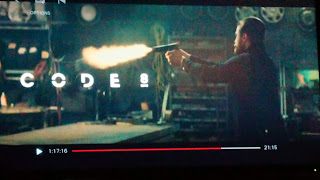 Perfect Pauses is probably not only my most infrequent recurring "series" on this blog, but also the most inconsequential.
Perfect Pauses is probably not only my most infrequent recurring "series" on this blog, but also the most inconsequential.And yet I'm back, undaunted, with my fourth in about four-and-a-half years, and my first in just over two.
Technically speaking I did my first back in 2011, when I wasn't anticipating a series and called the post "Great pauses in movie history." It took until 2016 to start recognizing it as "a thing."
Anyway, the idea is that if I'm pausing whatever I watch and the pause happens to time out just about perfectly, I'll write about it here. Deep, right?
So the latest was Code 8, a movie that got a blink-and-you'll-miss-it release last year in the U.S. before becoming a hit on Netflix upon its recent release there. I'm quite attuned to what's new on Netflix these days, as I'm reviewing whatever I can on what I can now call my sister site, Reelgood.com.au. (I'm running it now, hence the "sister" designation.) Code 8 had already piqued my interest when I realized it was not technically a "new" release (though it's probably new to Australia). So I watched it Friday night even though I don't expect to review it.
I'll get to a little bit of my thoughts on it in a minute, but first, the pause:
Given that the fire out of the muzzle of a gun is visible for only a split second, I thought it was pretty cool that I happened to catch this one in its brief moment of ephemeral existence.
Of course, I considered the fact that this is not the natural action of the gun and it could have been enhanced by special effects, but that doesn't really make it any less cool, as it's still on screen for only a split second.
And that's really just about all I have to say about the pause.
As for the movie, I thought it was a pretty good little low budget sci-fi action flick, with a nice premise. (I say "low budget" more because it has inexpensive stars than because it looks anything less than first rate.) The premise is that in a near future world, some statistically significant percentage of the population is discovered to have been born with super powers. Not all-powerful super powers like Superman, but one specific type of power per gifted person -- some can read minds, some can control electricity, some have telekinesis, some can heal. In no case does it make them immortal, so they can be taken down through ordinary gunfire or anything else that would usually kill a person. Their powers are heavily regulated by the government -- you have to have a permit to use them, and they're only intended to be used for work. (Which makes them good day laborers, as you can build a building faster if you can toss cinder blocks to each other like it was nothing.)
The world is approaching a total lockdown of these powers, as there are numerous incidents where a "power enabled" person has been guilty of a crime/caused a disaster/etc. There are Robocop-type police who can identify the power-enabled via facial recognition and fly around in the type of transports you see in the poster above. In any case, one particular construction worker (played by Robbie Amell) is trying to save his sick mom and falls in with a gang of criminals.
It's pretty entertaining stuff. It joins a small fraternity of recent lower-budget sci fi movies that I liked more than I was expecting to, which also includes Kin. I don't remember it particularly well the morning after, but it was a nice little diversion in the moment, and well made.
I did have a funny moment during the end credits as I had turned my attention to something else while they were rolling. I looked back up a minute or two later and thought "These credits are still on? What the hell?" Then of course I realized that minute upon minute of credit time was being devoted to the names of the people who had helped crowd source the film. (That's 30,810 contributors, according to Wikipedia.) And at first I'd thought it was just a really big visual effects department.
Back sometime in late 2021 with another perfect pause.


No comments:
Post a Comment